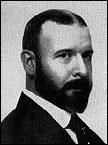Louis H Sullivan
 Considered to be one of America's most influential architects, Louis Henry Sullivan (1856- 1924) was born in Boston and initially worked for renowned Philadelphia architect Frank Furness. He came to Chicago in 1873, where he worked briefly for William Le Baron Jenney, the so-called "father of the skyscraper." After a year of study in Paris, Sullivan returned to Chicago and became a draftsman for John Edelman, whose luxuriant organic ornamental designs had a significant influence on Sullivan. In 1879, Sullivan joined the firm of Dankmar Adler (1844 - 1900), one of the city's most outstanding structural engineers.
Considered to be one of America's most influential architects, Louis Henry Sullivan (1856- 1924) was born in Boston and initially worked for renowned Philadelphia architect Frank Furness. He came to Chicago in 1873, where he worked briefly for William Le Baron Jenney, the so-called "father of the skyscraper." After a year of study in Paris, Sullivan returned to Chicago and became a draftsman for John Edelman, whose luxuriant organic ornamental designs had a significant influence on Sullivan. In 1879, Sullivan joined the firm of Dankmar Adler (1844 - 1900), one of the city's most outstanding structural engineers.
Their 15-year architectural partnership produced some of the most important--and influential--structures in the history of American architecture. By boldly rejecting the accepted practice of buildings based on historic design precedents, Adler & Sullivan created original designs that evolved from the functional requirements of each project, as well as the materials and technologies of the time. In doing so, Sullivan created a distinctive style of ornament that embraced natural forms.
Initially, the firm's work was limited to residences and small commercial buildings, such as the Ryerson and Troescher (both demolished), Eliel House, Jewelers' Building, and Kaufmann Store and Flats. However, in the late-1880s and early-1890s, their work grew in scale, with such skyscrapers as the Stock Exchange and Schiller Theater (both demolished), the Auditorium, the Wainwright in St. Louis, Mo., and the Guaranty buildings in Buffalo, N.Y. After the partners split in 1895, Sullivan designed the Carson Pirie Scott department store, the Gage Building, and the Bayard Building in New York. Following the turn of the century, his work largely consisted of small banks, stores, and churches throughout the Midwest, including Holy Trinity Russian Orthodox Church and, his final design, the Krause Music Store.